Table of Contents
VCS Random Testing
Create Test
To create a new test, first open up EDM. On the VCS Start Page, select Random under the Create a test tab.
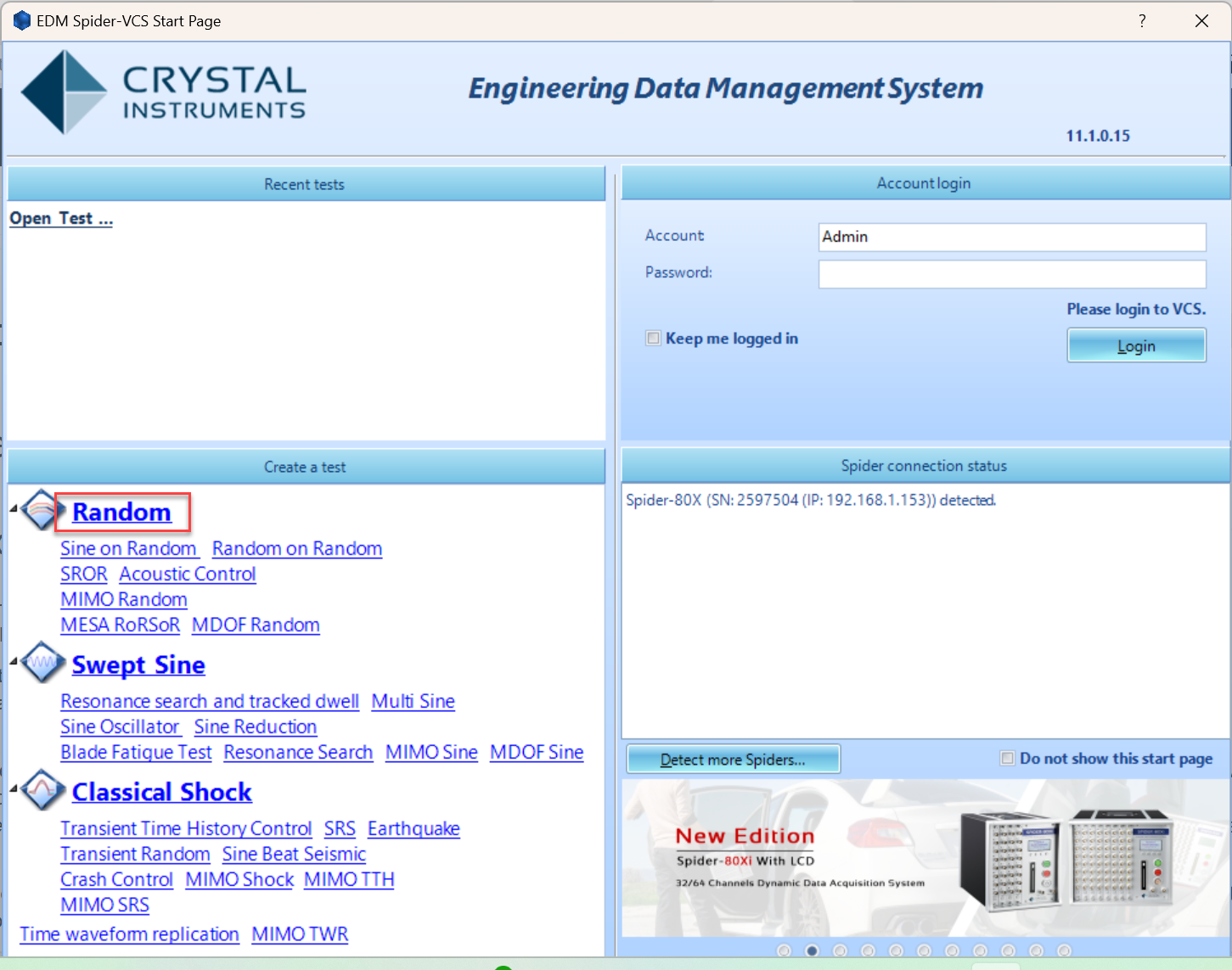 The New Test Wizard will now open up. From here, select Random again and then press Next.
The New Test Wizard will now open up. From here, select Random again and then press Next.
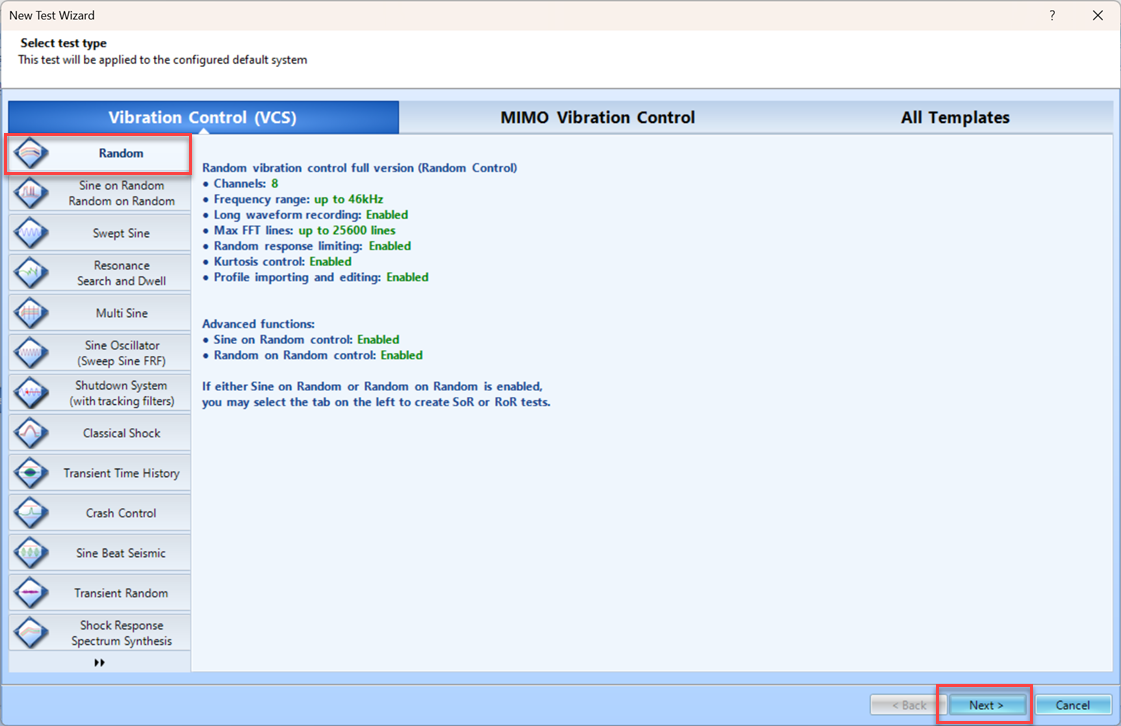 Finally, give the test a name and select the Spider system that will be used to run the test. Once all is complete, press Create.
Finally, give the test a name and select the Spider system that will be used to run the test. Once all is complete, press Create.
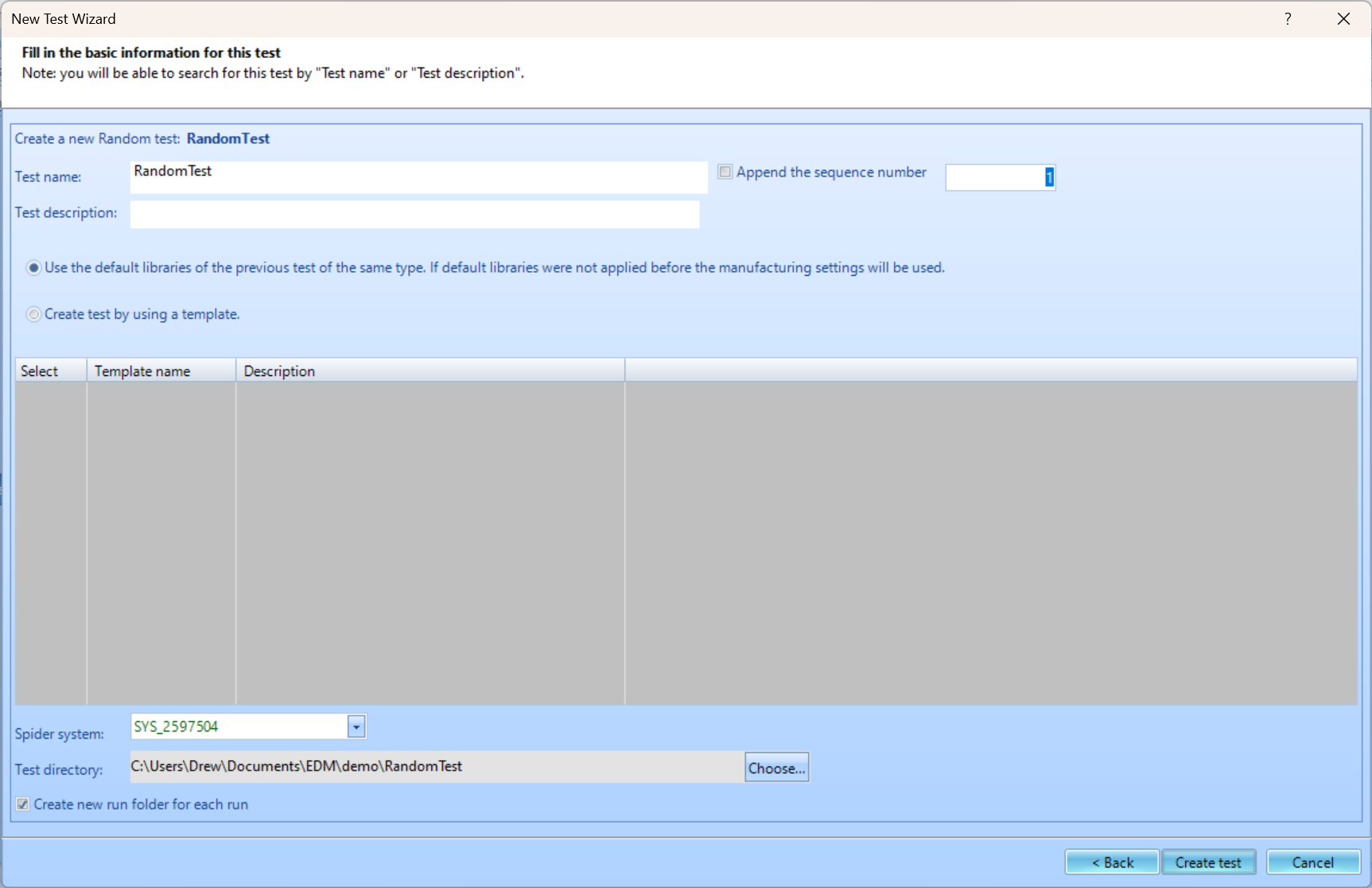
Test Configuration
The test will now need to be configured to run. This includes inputting information regarding the shaker, creating the schedule for the test to follow, and determining the parameters for the frequency analysis. To access the Test Configuration menu, press the Config button that can be found on the right side of the screen.  Shaker Parameters
Shaker Parameters
Click on Edit Parameters and enter the information from the shaker specifications. This is important for the safety of the shaker and testing unit. 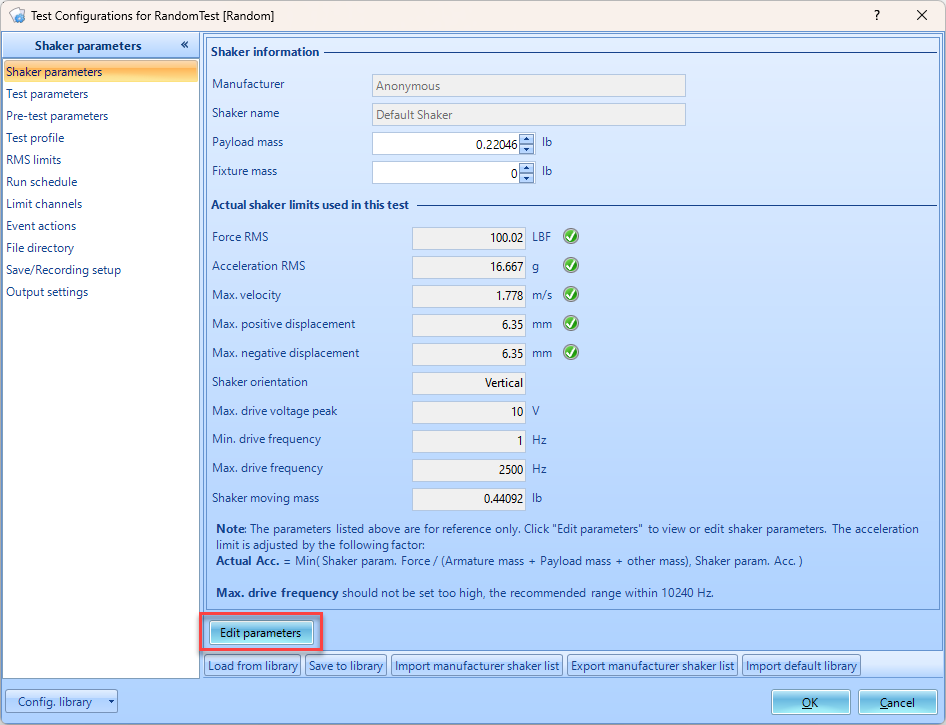
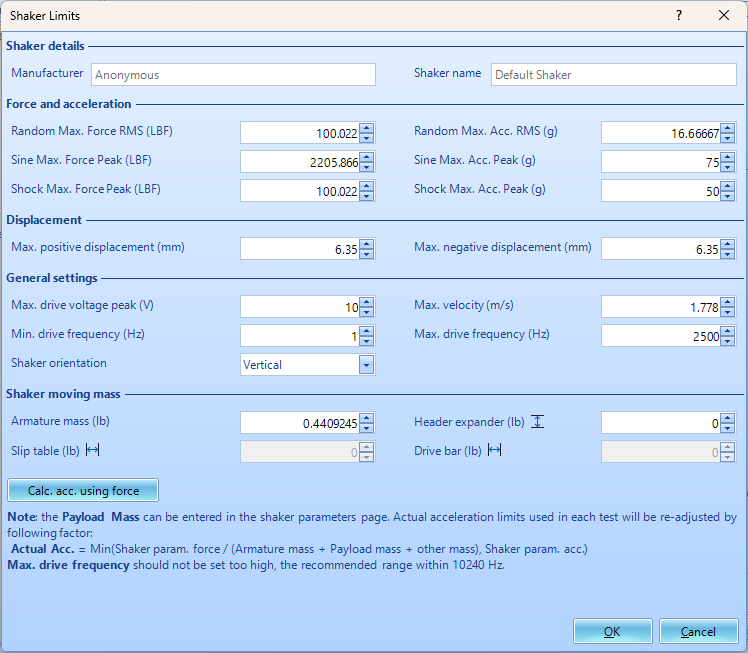
Test Parameters
The Test parameters section in the Test Configuration window has settings for the analysis parameters, abort sensitivities and control strategy.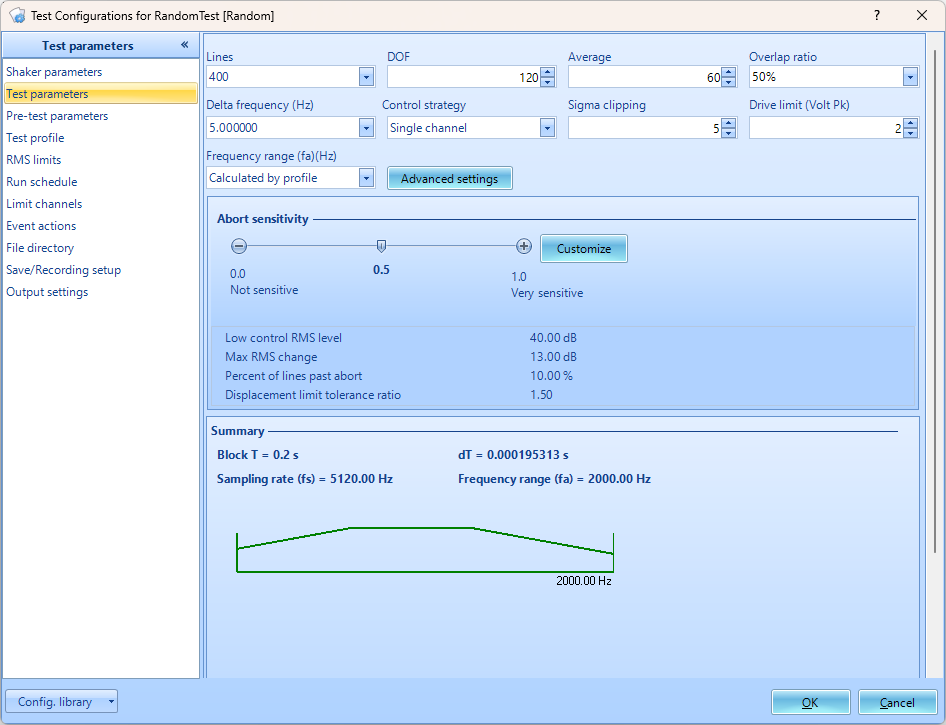
Lines- The useful number of spectral lines, proportional to block size. Increasing the lines / block size will improve the resolution of the frequency spectrum (allowing better detection of lower frequencies) at the tradeoff of increased calculation time and slower response.  Control Strategy- Determines whether one or multiple control channels are used, and how the composite control signal is generated (if multiple channels are used). Test Profile
Control Strategy- Determines whether one or multiple control channels are used, and how the composite control signal is generated (if multiple channels are used). Test Profile
The test profile is defined in the Test Profile section of the Test Configuration window. A graphical preview of the profile plot is displayed above, with a breakpoint table below for entering the profile. CSV import / export is also supported as an alternative to profile editing.
Breakpoint Table: Breakpoints can be added via Insert row, Delete row and Append row. Use Clear table to clear out all rows except for the first and last row. Breakpoint Calculation: In the profile editor, EDM can calculate the crossover point given a specified slope and point value. If a ‘?’ is entered as a Frequency or Amplitude value, EDM will interpolate that value given the slope before and after that point.
RMS Limits
The overall RMS level of the control channel(s) is monitored with alarm and abort limits. These limits are set under the RMS Limits section of the Test Configuration window. The table displays the expected RMS and peak values for the configured broadband profile, compared to the shaker limits as a percentage. 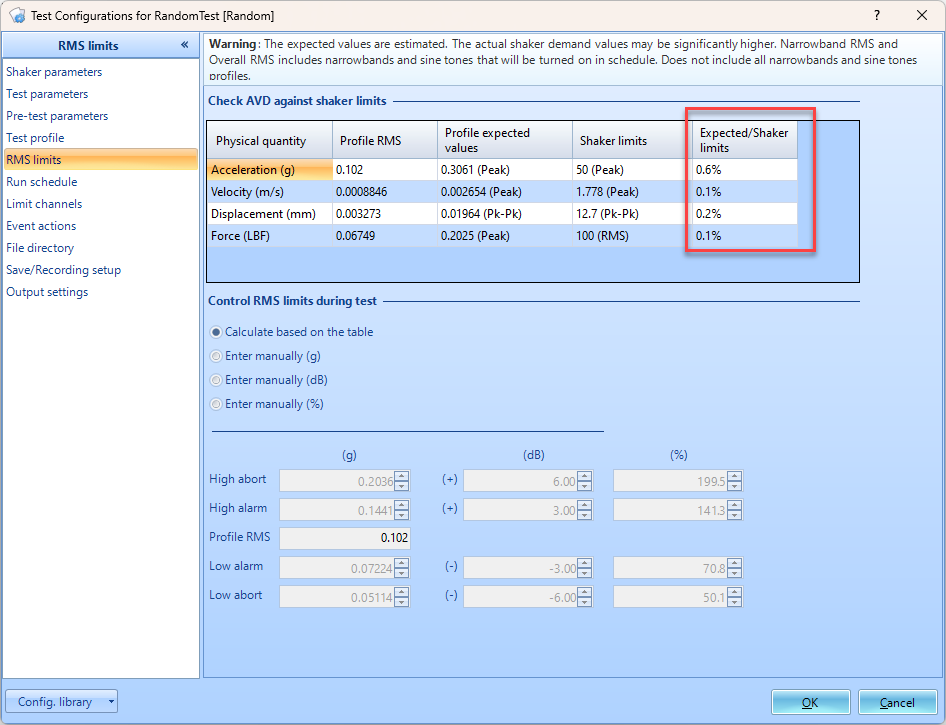
Run Schedule
The Run Schedule defines how the test is run automatically through a preset routine. This schedule can support loops and periods of running at a specified level and duration. The Run Schedule can also include user-defined events in Event Action Rules. 
Start a loop- Adds a new loop to the schedule – EDM will open a prompt for how many times to loop. Double-click on an existing loop number to edit the number of times for that entry.
Run at Level- Adds a new entry to run the test profile at a specified level. Schedule duration must be specified, as well as level as a percentage or dB of the target profile.

Input Channels
The input channels will now need to be set up. All sensors will to be properly configured before testing. The Input Channels menu can be found through Setup → Input Channels.
 Channel Type
Channel Type
Control vs. Monitor. When running a test, there will need to be at least one control sensor. The control sensor is used to monitor the actual vibration levels that the shaker is producing. It then sends this data to the controller so that it maintains the targeted profile. This sensor should be mounted somewhere on the shaker/slip table itself, not the Device Under Test (DUT). Monitor sensors will show the levels that the DUT itself is experiencing.
 Measurement Quantity
Measurement Quantity
Defines the physical unit that will be measured by the sensor connected to the channel.
Sensitivity
Sets the proportionality factor for the measurement (millivolts per engineering unit) given as a parameter of the sensor.
Input Mode
There are five modes in which the inputs can operate:
DC-Differential- In the DC-Differential mode, neither of the input connections is referenced to the local ground. The input is taken as the potential difference between the two input terminals, and any potential in common with both terminals is canceled out. The Common Mode Voltage (CMV) will be rejected as long as the overall input voltage level does not saturate the input gain stage. Beware that very high CMV will cause clipping and may damage the input circuitry. Signals with a nonzero mean (DC component) can be measured in this mode.
DC-Single End- In single-ended mode, one of the input terminals is grounded and the input is taken as the potential difference of the center terminal with respect to this ground. Use this mode when the input needs to be grounded to reduce EMI noise or static buildup. Do not use this mode when the signal source is ground referenced or ground loop interference may result. This mode also allows signals with a non-zero mean to be measured.
AC-Differential- AC-Differential is a differential input mode that applies a low-frequency high-pass (DC-blocking) analog filter to the input. It rejects common mode signals and DC components in the input signal. Use this when DC and low-frequency AC voltage measurements are not required or when a DC bias voltage is present. The analog high-pass filter has a cutoff frequency of -3dB at 0.3 Hz, and -0.1dB at 0.7 Hz for the IEPE input mode.
AC-Single End- AC-Single End grounds one of the input terminals and enables the DC-blocking analog filter. Use this mode for non-ground referenced sources where measuring the DC or low-frequency components are not required. It shares the same high-pass filter as that of AC-Differential.
IEPE (ICP)- All Crystal Instruments products support IEPE (Integral Electronic PiezoElectric) constant current output type input channels. IEPE refers to a class of transducers that are packaged with built-in voltage amplifiers powered by a constant current. These circuits are powered by a 4 mA constant current source at roughly 21 Volts.
Charge- Some sensors provide a high-impedance charge output. Usually, these are high-sensitivity piezoelectric units that lack a built-in voltage mode amplifier (i.e. IEPE), allowing them to be used in high-temperature environments. The Spider-81 front-end module has a built-in charge amplifier that allows the system to read the output of these sensors

Running the Test
Now that all of the parameters for the test have been setup, the test is ready to run. Here are the final steps to start the test.
- Press the Connect button to connect to the controller.
- Press the Run button.
- The Spider Check List will now appear. Here you can check the settings of the test and verify that all is set up properly. Press Start once this has been verified.
- The Pre-Test will now begin. This will verify that the control loop is properly established and provide data that the control loop needs.
- The test is now running